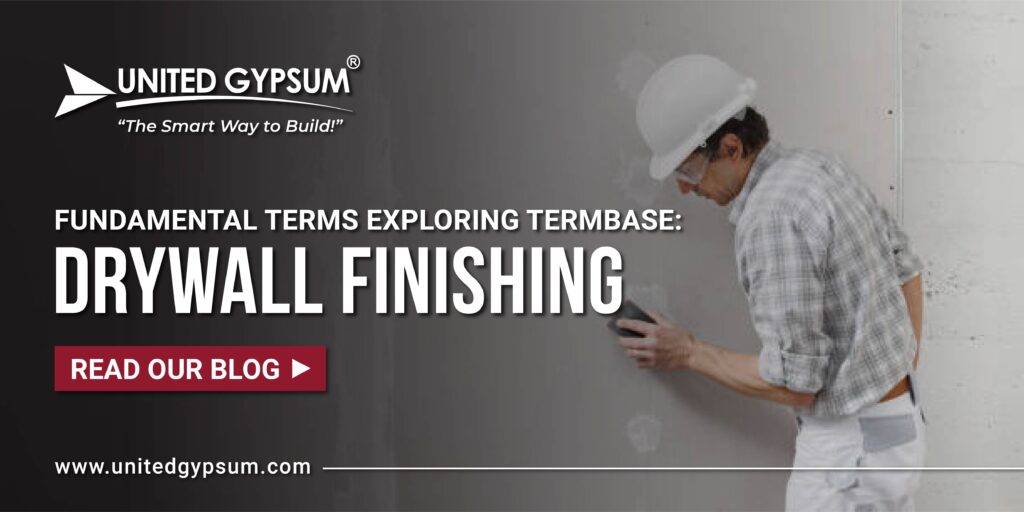The key vocabulary commonly used to describe drywall finishing materials, tools, and techniques is vast and complex. In this article, all such important terminologies will be explained so keep reading.
Drywall, also known as Gypsum Board or Wallboard, is frequently used in the modernized construction of walls and ceilings. A standard drywall construction procedure involves multiple stages from framing and installation to final finishing.
Drywall installation involves the cohesion of the gypsum board and panels onto the unfinished solid surfaces. However, the ultimate process of drywall finishing intends to furnish a seamless, monolithic surface which can then be embellished by paint or wallpaper as desired.
Although, finishing the drywall is the penultimate process but it involves various tools, techniques, and strategies that are briefly described below.
Drywall Finishing Terminologies:
- Butt joint: the non-tapered junction formed when two short sides of a gypsum board panel meet end-to-end.
- Beading: also called joint ridging; presents as a linear deformation in the joint between two gypsum board panels; usually occurs due to compressions resulting from the application of excessive force than necessary.
- Bond failure: occurs when the gypsum board panel and joint compound lack adhesiveness.
- Bed coat: the first coat of joint compound applied between joints to produce a surface for tape implantation.
- Black coat: the second coat of joint compound applied over the surface covered in joint tapes.
- Corner bead: allows a smooth and durable juncture between angles of the drywall thus providing a quality finish.
- Joint crowning: arises due to deficiencies in joint treatment such as excessive joint compound or inadequate application.
- Joint taping: the utilization of paper tape to conceal and reinforce joints, screws, and nails to create an appearance of monolithic architecture.
- Joint compound: also called drywall mud or mastic; has a spreadable consistency and is used to seal joints to create a coherent base.
- Dry time: the time required between consecutive coats to allow sufficient time for the joint compound to dry.
- Inside corner: the perpendicular intersection between two walls or a wall and a ceiling.
- Mildew: refers to the whitish coating due to the growth of fungal hyphae on plants and damp organic matter such as paper.
- Moisture protection: the ability of specifically designed gypsum boards to resist moisture and mildew.
- Mud pan: a rectangular tray used to hold and carry drywall mud or joint compound.
- Nail pops: the small defects in the drywall due to the protrusion of the nail head and caused by expansion or contraction of the wooden frame.
- Photographing: the color contrast created by variations in drywall face paper and joint compound.
- Ready-mix: the joint compound that is available in pre-mixed forms in containers and achieves the final hardness by drying.
- Levels of finish: five clearcut levels of professionally defined standards for drywall finishing.
- Sandpaper: a paper strip covered by abrasives on one side intending to smooth and even the drywall mud.
- Sanding sponge: a foam sponge with abrasives attached on one side to achieve a smooth and even drywall surface.
- Sanding screen: a refined version of sandpaper to smooth the drywall and plaster.
- Setting time: the time required by the joint compound to achieve its final state after mixing.
- Setting joint compound: a joint compound that undergoes hardening by a chemical reaction after mixing the constituents.
- Working time: the time duration for which the joint compound remains in a workable condition after mixing.
- Skim coat: a thin layer of drywall mud painted over the wallboard to rid it of blemishes.
- Spray texture: the technique by which a joint compound is applied in a scattered way to create a textured solid surface.
- Starved joint: an indentation that arises around the joints between gypsum panels due to the lack or inadequate drying of joint compound.
Drywall Finishing Tools
The following tools are used routinely in the process of finishing a drywall surface.
- Banjo: a manual tool used to apply the coatings of drywall mud and drywall tape with efficiency and precision.
- Bazooka: a long-armed manual tool used to apply coatings of drywall mud and drywall tape with efficiency and precision; allows more drywall mud to be carried around each time.
- Paddle mixer: allows convenient and quick mixing of copious amounts of plaster, joint compound, or paint.
- Finishing knife: a broad-bladed instrument used to apply finishing coats of drywall mud.
- Sander: a tool to which sandpaper with abrasives is attached and used to smoothen the drywall surface.
- Pole sander: a manual sander used to sand down large surfaces with the objectives of rapid pace, greater surface area, and lesser time.
- Orbital sander: a sanding tool operating through specially designed discs with abrasives to smooth out the solid surfaces.
- Taping knife: an indispensable tool to apply coatings of joint compound and drywall tape.
- Towel: a handy instrument to apply fine coats of drywall mud.
If you’re looking for well-functioning and brilliantly effective gypsum boards and related finishing products, United Gypsum is without a doubt the go-to place for all gypsum related solutions. With enduring technological acumen, our premier gypsum products aim to solve all your construction-related challenges. The client-centric policies and efficacious benefits will surely live up to your expectations!
Feel free to contact us if you have any queries related to Gypsum Products and related accessories.

